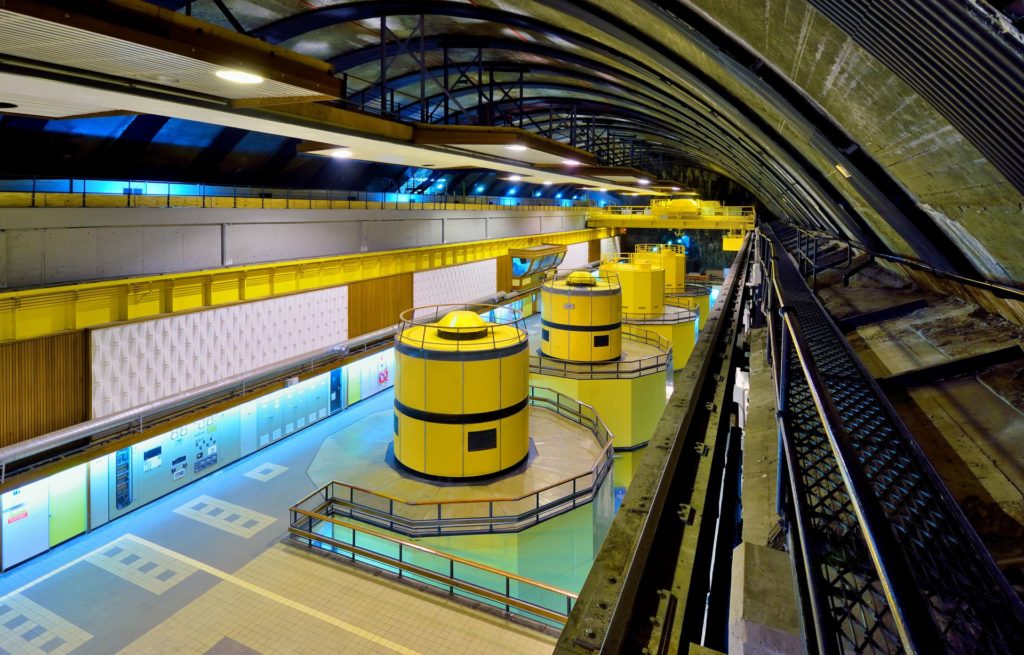Pumped storage is an extremely mature technology – it has been in use for over a century now. The oldest operational Pumped Storage plant is Engeweiher in Switzerland, built in 1907.
It’s about as simple as energy storage can be. By moving water up ‘a hill‘ when there is excess energy, and then releasing it down ’a hill‘ when there is need of energy, we can create a very simple, and long-lasting ‘rechargeable battery’. Unlike chemical batteries, which tend to degrade over time, the lack of complex parts leads to pumped storage being a much resilient method of storage.
How it works?
Pumped storage needs two reservoirs with a height difference between them. This allows the storage of energy as potential energy using the force required when moving water upwards against gravity – think of lifting a heavy rock (storing energy) and then dropping it (releasing energy).
In most cases one of these reservoirs will be manmade, and one will be natural to reduce the construction costs. The location of pumped storage schemes is therefore dependent on large natural reservoirs, which is why Scotland with it’s plethora of lakes is an ideal location.
The two reservoirs are connected with pipes which run through a ‘powerhouse’. The powerhouse contains all the necessary equipment to pump water up to the upper reservoir, and generate energy from the flow of water down to the lower reservoir. Often the turbine used inside the powerhouse can be operated as both a pump and alternatively a generator.
When excess power is being generated on the grid, the powerhouse is tasked with moving water up to the upper reservoir to store. When power is required the powerhouse will operate in reverse, to convert the energy stored back into electricity.

Depending on the size of the reservoir and the powerhouse connecting them, this pumped storage can be assigned power rating and a capacity. The capacity is the power that can be produced by the turbines (in the powerhouse) at full output while the power storage is based upon the amount of water that can be stored in the upper reservoir.
Benefits
The storage of energy
It can help us store energy when it is overproduced. This is much more important with renewables as these tend to be very variable in power output. For example when it is more windy then normal we can ‘charge’ the pumped storage, and then we can discharge when we aren’t producing enough energy.
Inertia
Due to mechanical flywheels, pumped storage provides an intrinsic inertia which is key to damping short term fluctuations in grid demand and production.
Quick ramp up times
Pumped storage can be quickly ramped up when higher demand is required by the grid then is being produced. The fastest pumped storages can go from off to producing in around 15 seconds.
Black start the grid
Some generators can require initial electricity for start up. When there is no electricity such as during large power outages this is an issue. Since for pumped storage the potential energy is in a form easily released without a large initial potential barrier there is no such electricity requirement.
Negatives
Impacts on natural landscapes
The building of an artificial reservoir and pumphouse can damage the views. They can be somewhat hidden by making use of surrounding hills, and sometimes the entire pumphouse is hidden underground.
Environmental Concerns
Adding a large reservoir to a natural landscape destroys many natural habitats. There are also effects that pumped storage can have on geology, soils, groundwater quantity and local aquatic ecosystems, which need to be researched and addressed. Although these environmental concerns are important, it is important to note that if energy storage is not solved, the environmental impacts of the continuance of fossil fuel usage will have a much greater impact on a much wider ecosystem.
Space requirements
To store significant amounts of energy the reservoirs have to be large.
Pumped Storage Locations in the UK
Operational
There are four currently operational pumped storage power plants in the UK – two in Scotland and two in Wales. Combined, these give a total power output of 2.8GW and more than 25GWh of energy storage. Cruachan, Scotland has expansion plans aiming to increase the power that it can output by more than double.
Ffestiniog, Wales
The decision to proceed with the building of Ffestiniog power station was made in 1953, with the power station becoming operational in 1963 (sourced). Although, the oldest of all the UK pumped storages it still has a relatively large output capacity.
Capacity: 360MW
Storage: ~1GWh

Foyers, Scotland
Foyers is a unique power station in this list. It was originally developed as a hydroelectric power station in 1896 – the first large scale hydroelectric project in the UK – but in 1969 focus was put on redeveloping it into primarily a pumped storage scheme. In fact it still produces a modest amount of classic hydroelectric power 5MW.
Capacity: 300MW
Storage: ~6GWh

Cruachan, Scotland (Hollow Mountain)
Cruachan Power station was opened by Queen Elizabeth in 1965, but had been conceived many years earlier in 1930. Although opened in 1965, two of the turbines didn’t become operational until 1966 and 1967 when it finally could reach full capacity.
Capacity: 440MW (expansion plans submitted for 1.04GW)
Storage: ~10 GWh

Dinorwig, Wales (Electric Mountain)
Dinorwig is the newest of the four pumped hydro schemes in the UK, and was finished after 10 years in 1984. At this time it was the largest civil engineering project that had been commissioned in the UK, and was branded extremely imaginative for hiding all the power generation equipment within the ‘mountain’.
Capacity: 1728MW
Storage: ~9GWh

Planned Pumped Storage Schemes
Glyn Rhonwy, Wales
Cruachan Expansion, Scotland
Glenmucklock, Scotland
Corrievarkie, Scotland
Red John, Scotland
Red John is a proposed pumped storage using Loch Ness as a reservoir. The contract has been awarded to renewable energy developer Intelligent Land Investments (ILI) Group by the Scottish Government. The planned capacity is to be 450MW.